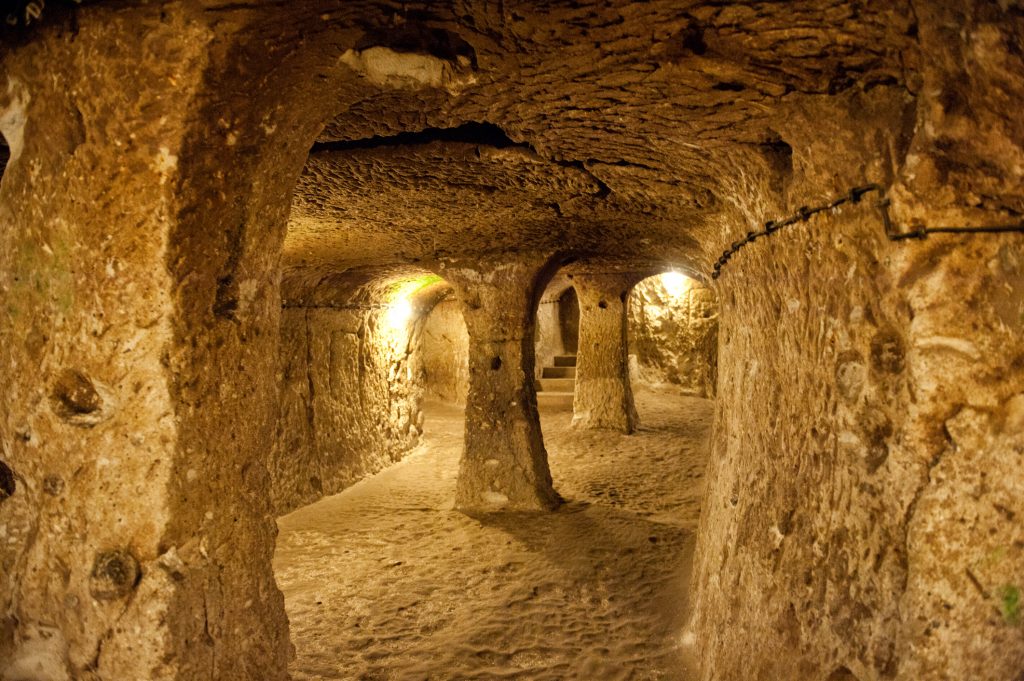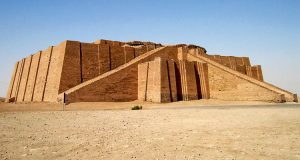It was just a regular day for Mustafa Bozdemir in 1963 as he made renovations to his home in Nevşehir Province, Turkey. That is until Mustafa knocked down a wall of his home and behind it, discovered a whole new room. Connected to this room was an entire city built for nearly twenty-thousand people.1 This city is what became know as Derinkuyu, one of the ancient world’s biggest mysterious.

What we know about who built and lived in the city of Derinkuyu still remains unknown. According to one theory, the city’s beginning dates to 800 B.C.E. when Derinkuyu was built and inhabited first by the Hittites from the Old Kingdom period for an estimated short one-hundred years.2 After the fall of the Hittites around 700 BCE, historians have come to the conclusion that the Phrygians inhabited Derinkuyu.3 Derinkuyu was a sanctuary for the people who lived above ground in the Cappadocia region of modern-day Turkey. The entire region of Cappadocia above Derinkuyu was under constant attack. Since they were under constant attack, this inspired another theory that the majority of the twenty-thousand people who lived within Derinkuyu were refugees from the war between the Arab tribes and Byzantine Christians who were at war overhead around 650 BCE.4

Derinkuyu was equipped with amenities, created with technology far beyond their time. Such amenities included housing for livestock, ventilation chimneys, churches, and schools.5 Archaeologists were baffled by the design of Derinkuyu. The engineering used to build Derinkuyu was with a technology that seems to be from a later time. The cities were carved out of volcanic rock found underground. Since protection was their number one priority, multiple mechanizations were put in place in order to ensure their protection.6 Such mechanization included rolling stone doors to close off various tunnels. In the case of an attack, the rolling stone doors would block any entrances to trap intruders within the tunnel. In the roof of the tunnels, what would appear to be ventilation holes, were actually holes to pour oil on any intruders.7
Derinkuyu was a thriving city for an estimated four-hundred years. Another question historians have about Derinkuyu is what happened to its people? Once Derinkuyu was discovered, it did not take researchers long to learn that it was connected to multiple other underground cities in the surrounding area, including Goreme and Kaymakli.8 Historians have come to the conclusion that Derinkuyu must have been under attack, and people fled to one of the surrounding cities; however, it is still uncertain.

The majority of Derinkuyu’s history may never be known; however, this mysterious city is still an important part of ancient Turkey. Derinkuyu has influenced engineers today to consider the possibility of building underground cities as the population and need for living space continues to grow. Today Derinkuyu has become a tourist attraction for people all over the world.9
- Vladimír Nývlta, Josef Musíleka , JiĜí ýejkab , Ondrej Stopkac, “The Study of Derinkuyu Underground City in Cappadocia Located in Pyroclastic Rock Materials,” Procedia Engineering 161 ( 2016 ): 2253. ↵
- Fitzroy Dearborn, The Hutchinson Dictionary of Ancient and Medieval Warfare (London, UK : Reaktion Books, 2016), 146. ↵
- Benedict Anderson, Buried City, Unearthing Teufelsberg: Berlin and Its Geography of Forgetting ( New York : Routledge, 2017), 13. ↵
- Dig into history, February 2016, s.v. “‘Uncovering’ an underground city,” by Catie Steidl. ↵
- Dobraszczyk, Paul, Galviz, Carlos López, Garrett, Bradley L, Global Undergrounds: Exploring Cities Within (London, UK : Reaktion Books, 2016), 35. ↵
- C. J. Lim, Inhabitable Infrastructures: Science Fiction or Urban Future? (New York, NY: Routledge, 2017), 279. ↵
- Tony Wright, Turn Right at Istanbul: A Walk on the Gallipoli Peninsula (Crows Nest, N.S.W. : Allen & Unwin, 2003), 67. ↵
- Henry Herman, Dominance and Aggression in Humans and Other Animals: The Great Game of Life (London, United Kingdom: Academic Press, 2017), 297. ↵
- Lynn Levine, Frommer’s Turkey: From the Blue Mosque to the Blue Lagoon (3rd ed. Hoboken, NJ : John Wiley & Sons, Inc, 2004), 344. ↵



71 comments
Sherisa Orozco
It’s incredible that such complex underground cities could have been built in 800 BC. This becomes even more impressive considering how many wars they were involved in at the same time. They definitely put more thought into the design of Derinkuyu. They constructed rolling stone doors to keep intruders out, and they holes drilled in the tunnel roofs to pour oil. Very interesting article!
Janaya Felder
I’d be so excited if I were to discover an entire underground city! I would love to visit it someday after reading this article. It would be so intriguing to see their use of technology and how they defended themselves firsthand. I did not even know this place existed until now which is really making me want to study more about it!
Kendall Guajardo
I loved hearing more about this underground city. The idea that people once inhabited and built underground cities with such complex amenities and considerations is amazing! The historical analysis of their occupation of Derinkuyu was interesting and looking into the time period more will bring more clarity to this theory. I wonder how the city has never collapsed and I really want to know the strength of this structure. I think the idea of an underground city is very cool. Knowing that history might contribute to solving the overpopulation crisis today is a remarkable turn of events.
Francisco Cruzado
I had never heard about the ancient citadel of Derinkuyu before reading this article, and I am grateful of learning about it today, as I got intrigued by the theories surrounding who might lived in those hallways and, specially, why was it there, underground. The theory on the possible war refugees sounds as a major possibility, and it encourages me to look more into the history of ancient Turkey. Assuming the theory is true, it get fascinated when thinking on how such a microsociety resembled the present communities of war refugees that populate Europe and the US, finding ties between them, points of convergence, and a similar narrative in their personal backgrounds, a past filled with a longing for happiness. Great article!
Sara Guerrero
I found it surprising that this hidden city was underground and the fact that their amenities were too ahead at their time makes me believe that other supernatural forces could have taken place. Also, the city is so old I wonder why it hasn’t caved on itself since it has been underground for so long. The influence this city has on the mindset of architects to possibly build underground cities and I wouldn’t be surprised if they have already started.
Glory Turnbull
This reminds me of the book “City of Ember”! This article really dispels the idea that people of the past were in any way lesser or more primitive than the people of today. They completed amazing feats of engineering and mathematics, much like these tunnels! I wonder if they’re open to the public today.
Olivia Tijerina
The article take place of identifying the discovery of the underground city that today puts into question of if we can do this today? Not for the same purpose, but to conserve space for a growing population. Or, what are the rest of the mysteries behind this city? The message delves into the underground city, Derinkuyu, which I find the motivation of the city was quite unity based on the capacity to carry in size and the function the structure was able to perform for its purpose.
Kimberly Parker
Building not only underground tunnels but cities as well during 800 B.C.E. is just outstanding. I mean all of the efforts that they would’ve had to put in, not to mention that they wouldn’t have had the type of tools that we have now, so it’s just so extraordinary that this exists. This is such a huge achievement, not to mention that it was gorgeous as well. It looks so serene. And putting rolling stone doors to block intruders, and holes in the roofs of the tunnels for pouring oil onto their enemies is just so innovative.
Kenneth Gilley
It is amazing that anyone could have built such elaborate underground cities in 800 BC. This is even more impressive given that they were involved in so much war at the same time. Obviously, they put a great amount of thought into the construction of Derinkuyu. They put rolling stone doors to block intruders, and they put holes in the roofs of the tunnels for pouring oil onto their enemies. This was a very interesting article!
Mauro Bustamante
The article was well written and very informative, in think of how hard it was to be able to build under ground tunnels during that time period. I mean now and days we have all these developed machines to be able to dig underground tunnels and during ancient civilization they really didn’t have the materials to be able to achieve that with ease. I have always been fascinated about the ancient tunnels that still are in place, and I wonder how long did it take the people to finish the process.